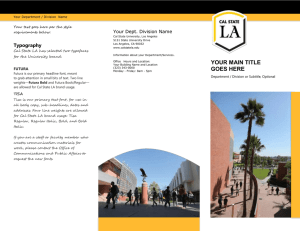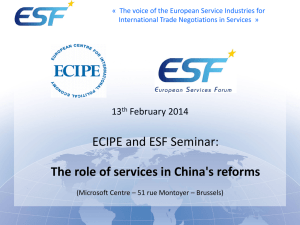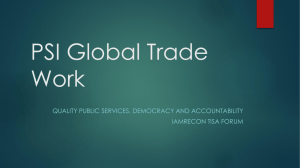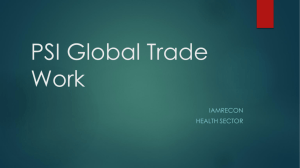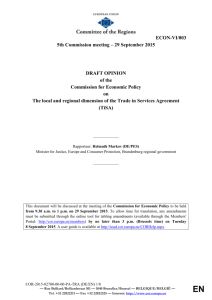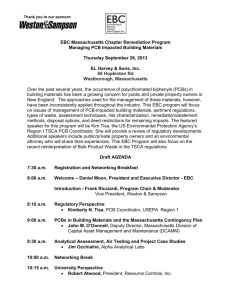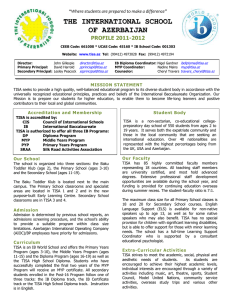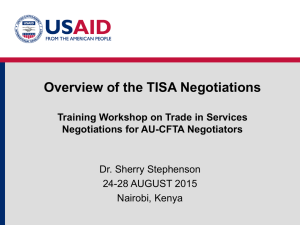en en working document
advertisement
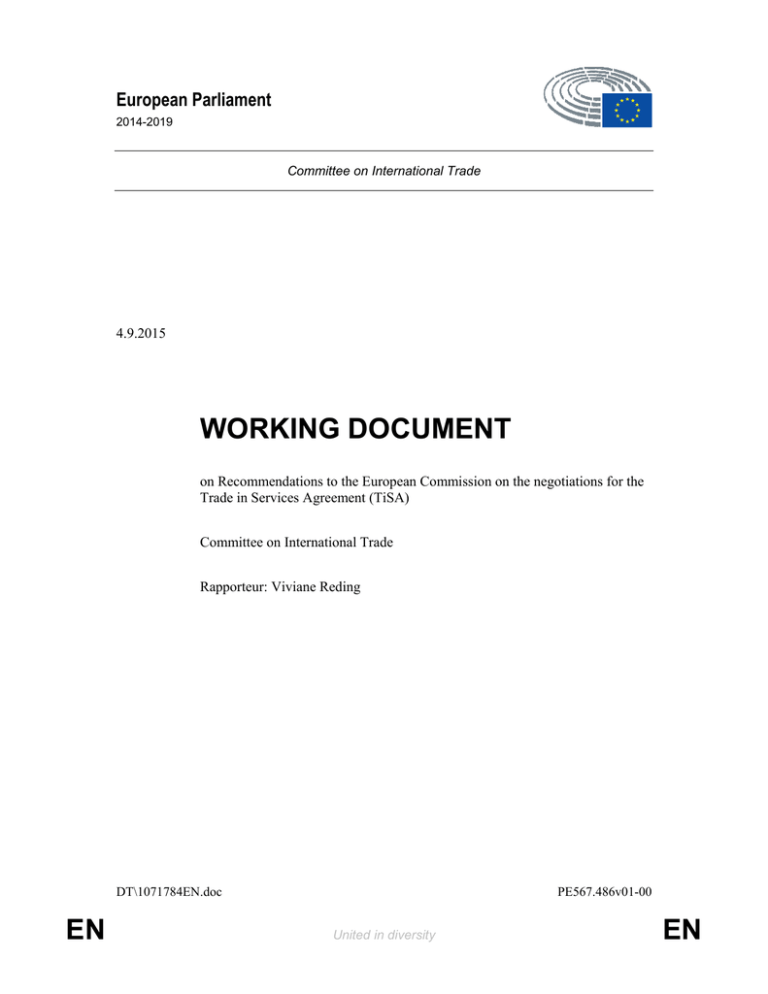
European Parliament 2014-2019 Committee on International Trade 4.9.2015 WORKING DOCUMENT on Recommendations to the European Commission on the negotiations for the Trade in Services Agreement (TiSA) Committee on International Trade Rapporteur: Viviane Reding DT\1071784EN.doc EN PE567.486v01-00 United in diversity EN Introduction The European Parliament plays a decisive role in EU’s trade policy. Not only its Members have the final say on trade agreements, they also have to be immediately and fully informed at all stages of the procedure of negotiating and concluding trade agreements, in order to exercise a continued oversight over trade negotiations. With the view to shape their course, this House is entitled to express its position throughout the process. Accordingly, by means of a report based on Rule of Procedures 108, your Rapporteur would like to assess the first two years and twelve rounds of negotiations on the Trade in Services Agreements (TiSA). The report will build upon the Parliament’s first resolution in July 2013 as well as the present working document, which provides background information, the Rapporteur’s preliminary position and questions for parties interested in contributing. 1. Why TiSA? The European Parliament needs to positivise TiSA. 1.1. To reinvigorate WTO negotiations on services Negotiations started in April 2013 to advance the stalled WTO talks with countries that are willing to make further progress on trade in services. Overall, TISA parties intend to break new grounds in market access commitments and to enhance international rules in several fields such as financial, digital and transport services. The current legal basis, the General Agreement on Trade in Services (GATS), dates back from 1995 and little progress has been made ever since. Hence, this plurilateral agreement is currently being discussed among 25 members1 of the WTO, with all the continents being represented. Altogether they represent 70% of global trade in services. Despite China’s request to join, none of the BRICS is taking part in the talks yet. That being said, TiSA aims at being multilateralised once a critical mass of countries is reached. This agreement is crafted to make it compatible with GATS in order to secure further integration. Therefore, a good TiSA can and must be a stepping stone towards renewed impetus at WTO level, not an alternative to multilateral governance. 1.2. To account for globalisation, servicification and digitalisation of trade GATS is meant to be upgraded to support the globalisation, the servicification and the digitalisation of both our economies and international trade. First, globalisation is characterised by an ever-increasing import content of exports from 20% in 2010 to 40% today and by the internationalisation of value chains, in which goods and services provided by different companies from different countries are assembled in a unique product. Second, servicification is best illustrated by the growing importance of professional, telecommunication and transport services, to which manufacturers increasingly resort to respectively navigate the regulatory environment in a foreign country, to set appropriate 1 List of TiSA participants (at this time): Australia, Canada, Chile, Chinese Taipei, Colombia, Costa Rica, the EU, Hong Kong, Iceland, Israel, Japan, Korea, Liechtenstein, Mauritius, Mexico, New Zealand, Norway, Pakistan, Panama, Paraguay, Peru, Switzerland, Turkey, the United States and Uruguay. PE567.486v01-00 EN 2/6 DT\1071784EN.doc connections between a company’s different locations and to reach out to their consumers abroad. With 75% of services trade relating to intermediate services, services are key inputs to all economic outputs. Third, digitalisation coincides with the rapid development of the Internet. For the past two decades, the number of users has jumped from 16 million to 2.7 billion. Data flows have become the backbone of our economies and the bedrock of international trade, with the stock of data doubling every 20 months. As a result, barriers to trade in services within and outside Europe often undermine the competitiveness of the European economy. Therefore, a good TiSA can and must increase reciprocity in market access, and not set in stone the current level of asymmetries. 1.3 To shape globalisation In today’s interconnected world, physical barriers are being increasingly dismantled. It is costly for businesses and unsatisfactory for consumers to replace them by unnecessary regulatory barriers. While the world knows no border, rules must be borderless too. Trade in services is where the highest growth potential and the highest trade barriers lie. In the next few years, they will have to be torn down to reap the associated benefits. By 2050, Europe will represent only 7% of the world’s population, down from 20% in 1950. By 2050, Europe will represent only 15% of the world’s GDP, down from 40% in 1900. By 2050, Europe might neither be the largest economy nor the largest trading block in the world. By 2050, it might simply be too late to shape state-of-the-art international rules. Before then, further integration is required between the EU and its partners. Only together can countries get bigger than they really are. Only together can countries level the global playing field so as to thrive in a networked world. Only together can countries be standards-makers, not standardtakers. Therefore, a good TiSA can and must be conducive to better international regulation, not lower domestic regulation. 2. How TISA? The European Parliament needs to demystify TiSA. 2.1. To recognise each Party’s sovereign right to regulate The framework for TiSA negotiations is threefold. The first part, called the core text, mirrors the horizontal provisions and general principles included in GATS. It also covers transversal exceptions and an explicit recognition of the right to regulate. The second part is made of each Party’s schedule of commitments, which consists of market access and national treatment commitments ("offers"). The former relates to the opening of a specific sector to foreign competition. The latter refers to the obligation to treat services providers from other parties no less favourably than its own services suppliers. The participants agreed on a hybrid approach for listing their commitments, with a positive list for market access and a negative list for national treatment. TiSA also lays down standstill and ratchet clauses, which can only apply to national treatment and not to market access, and which aim at respectively reflecting current practices and prohibiting the imposition of future DT\1071784EN.doc 3/6 PE567.486v01-00 EN restrictions beyond current commitments. By means of limitations and exemptions, each Party retains the sovereign right to choose which sector to open to foreign competition, to which extent and whether or not to apply these two provisions. The third part includes regulatory chapters, which lay down common rules and set standards for cross-border provision of specific services sectors, and typically cover issues such as licencing and qualification procedures, independence of regulators, fair market access authorisation processes, competition-related provisions, and non-discriminatory access to networks. At this stage of negotiations, 17 regulatory chapters have been proposed by all TiSA participants ranging from financial services to telecommunications, e-commerce, transport, professional qualifications, Mode 4, delivery services, among others; however, it is expected that in the end not all proposed chapters will find the required common support to be included in the final perimeter of TiSA. Hence, nothing has been agreed yet and nothing will be until everything is agreed by all Parties. Therefore, a good TiSA can and must duly shield sensitive EU sectors from foreign competition, including those particularly valuable to EU citizens. 2.2. To respect the European Parliament’s role in trade negotiations As enshrined in the Treaties, the European Commission negotiates TiSA on behalf of the EU on the basis of instructions given by Member States representatives (mandate), and shall report regularly to the European Parliament on the progress of the negotiations. Regrettably, the Council's mandate from March 2013 preceded the Parliament’s resolution and included very few recommendations. After the 2014 European elections, the Committee on International Trade decided to put in place a monitoring group to step up the involvement of the European Parliament in these negotiations. The role of this monitoring group is to get information from the Commission as well as to influence the work of EU negotiators. This two-way communication channel is of utmost importance to ensure accountability. In the end, the outcome of TiSA negotiations will come under public scrutiny before being put to a "Yes" or "No" vote in the European Parliament, which is hence empowered with the final word. Therefore, a good TiSA can and must be monitored, influenced and approved by democratically-elected policy-makers. 2.3. To take citizens on board Transparency is indispensable to discard suspicion. For the first time in EU's trade policy, the Commission published on its website on 22 July 2014 five TiSA-related documents, including three negotiating texts such as the EU initial schedule of commitments. It also provides online information about what TiSA is and what it is not. In March 2015, the Council declassified the TiSA mandate. In addition, the European Commission and the European Parliament regularly organise public consultations with NGOs, consumer groups, industry associations, and other interested parties, such as the public hearing organised by the International Trade Committee on 24 February. As this corresponds to the highest push for transparency ever seen in trade policy, dialogue and communication endeavours must be continued. Facts must prevail over fiction so that the negotiations take the right direction in the European interest. Therefore, a good TiSA can and must be open to social partners, civil society, business representatives and citizens to make sure they understand what is being done, who is doing what, and they feel they can influence the course of these negotiations. PE567.486v01-00 EN 4/6 DT\1071784EN.doc 3. What TiSA? The EU needs to prioritise TiSA. 3.1. To take a balanced approach to trade in services In the current public debate, polarised between those in favour of red lines only and those opposing any red lines, there is room for a third way. Between blissful optimism and widespread fear, ultra-liberalism and protectionism, there is space for pragmatism. Between an all-encompassing agreement and a full stop to TiSA negotiations, a balanced approach must prevail. Regulatory chapters cover a wide range of sectors (see above). Depending on the competitiveness and sensitivity of the sector, the pendulum of EU trade policy should shift back and forth from opening markets to competition to shielding them from external competitors. Therefore, a good TiSA can and must provide more rights to consumers at home and fewer obstacles to businesses abroad. 3.2. To ensure reciprocal market access for EU companies abroad Worldwide competition must be by the rules and not for the rules. First and foremost, reciprocity is a must. EU negotiators must seek higher access to foreign markets, not take one-sided commitments beyond our current level of openness. Those TiSA parties, which either do not have FTA negotiations with the EU (Australia, Hong-Kong, Israel, Taiwan, New Zealand, Pakistan, Paraguay, Uruguay) or very little commitments in services (Chile and Turkey), must be targeted. Europe is where the barriers to trade in services are the lowest. Translated into equivalent tariffs, these barriers amount to 6% of the price of a service. Computed for other countries, these obstacles yield 15% for Canada, 16% for Japan, 25% for South Korea, 44% for Turkey and 68% for China. Despite this high level of asymmetry, the EU remains the largest exporter of services, with 24% of the world share and with a trade surplus of €170 billion in 2013. Yet, it is unacceptable that foreign companies can compete with our enterprises on EU’s territory, while ours can simply not provide their services to foreign markets. It would be equally unacceptable if foreign companies did not have to abide by the same regulatory requirements when they provide their services to EU consumers. Second, fairer competition must prevail over a global race-to-the bottom. With the rise of Internet and the future of 3D printers, the risk of regulatory arbitrage is increasing. Instead, a global level playing field is needed, thereby putting each and every company on equal footing. Third, tangible benefits must be provided to EU consumers, both when they travel abroad and when they do online shopping. Therefore, a good TiSA can and must be a market-opener abroad and safety net for citizens at home. 3.3. To create a safety-net for EU citizens at home While a wide range of opportunities underpin these negotiations, several challenges could easily derail them. DT\1071784EN.doc 5/6 PE567.486v01-00 EN First, our European cultural and social model must not be weakened. Public services and culture, whose protection is enshrined in EU treaties, are not for sale. They are jewels rooted in Europe’s DNA. In addition to an horizontal reservation, which provides that public utilities may be subject to public monopolies or to exclusive rights granted to private operators, the EU takes no commitments in audio-visual, air transport (except for ground handling and aircraft maintenance services) and public services, such as public education and public health. While the negotiating text demonstrates the EU’s political will to widely exclude public services, it could be said more clearly, more simply and less equivocally by means of a goldstandard clause. Second, our fundamental rights must not be discussed as if they were trade barriers. For instance, the rights to data privacy and to fair working conditions are sources of economic growth. They are non-negotiable. Third, the right to regulate must be fully preserved. In several sectors, the EU maintains the right to adopt or maintain any measures. In others, this right is restricted to nondiscriminatory measures. Trade must be about trade, not about constraining democratic choices. Our political, social and cultural model is an asset, not a burden. Therefore, a good TiSA can and must be guided by the fundamental principles enshrined in the EU Treaties, as required by Article 21 of TEU. Conclusion TiSA cannot be labelled as cure or curse before it is finalised. Instead, the European Parliament must work constructively and pragmatically to positivise, demystify and prioritise TiSA negotiations so as to ensure that a good agreement is reached, in the interest of European companies and consumers alike. TiSA will be balanced, or it will simply not be. To this end, your Rapporteur would like to hear your recommendations on the following questions. What should be the EU’s main objectives in TiSA? How can the EU ensure wider participation in these discussions? What should be the perimeter for the negotiations? PE567.486v01-00 EN 6/6 DT\1071784EN.doc
